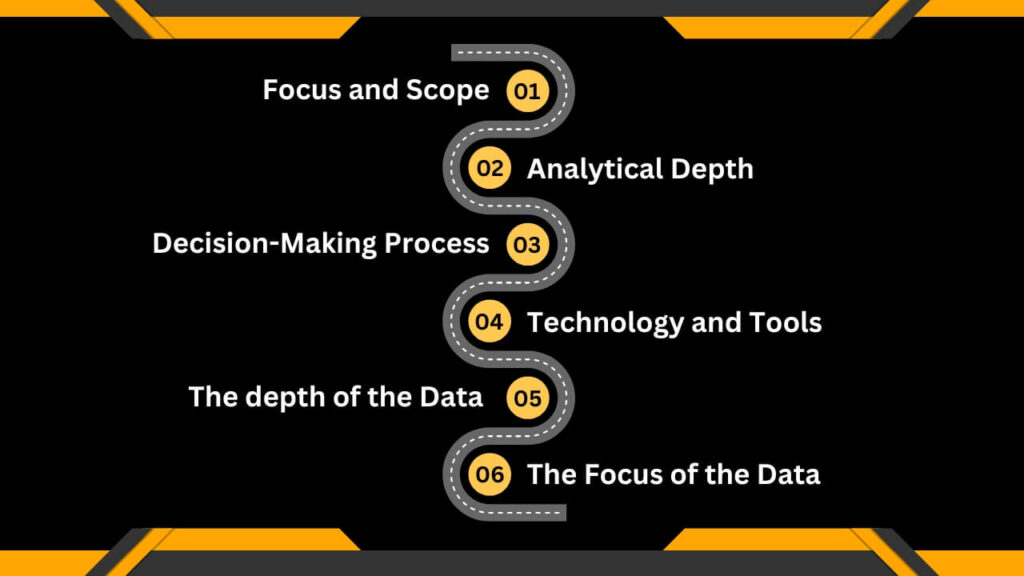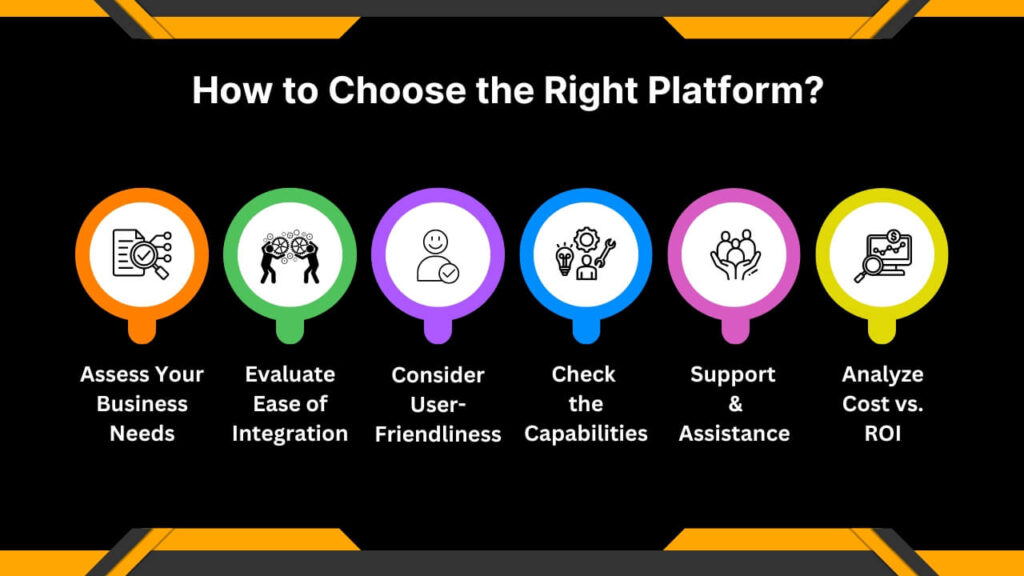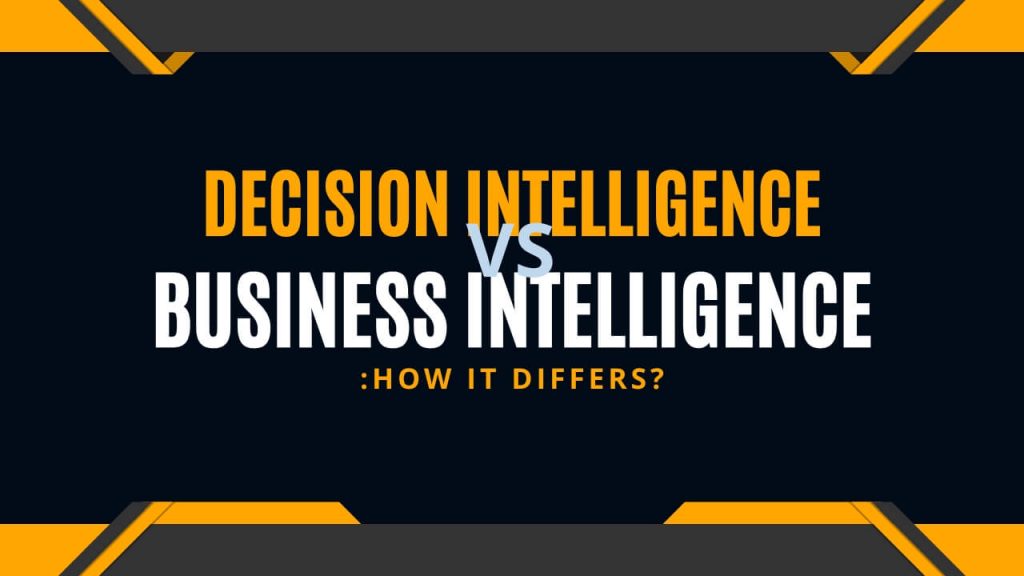“Business Intelligence is about understanding what happened and why. Decision Intelligence is about understanding what should happen next and how to make it happen.”
The term “data-driven decisions” may seem like a new notion, but individuals have been using data to make business decisions for centuries.
Thank you for reading this post, don't forget to subscribe!With the introduction of Decision Intelligence as a component of Business Intelligence, businesses have been sprinting to make sense of their data processes and deploy platforms and features that enable them to interpret large datasets.
Decision Intelligence and Business Intelligence are connected concepts, but have distinct areas and applications that allow them to collaborate and achieve the greatest business results. When they work together, they perform even better.
This blog will discuss the distinctions between business intelligence and decision intelligence as well as how they complement one another to deliver the best results. Keep scrolling to know more about it.
What is Business Intelligence?
Business intelligence refers to the procedures, systems, and devices that convert raw data into actionable insights. Business intelligence makes use of historical data to improve operations now and in the future.
Business users can access a variety of data types through BI tools, including unstructured data from social media and semi-structured data from third parties, as well as current and historical data from within the company. Users can use this data to acquire insights into how the company is operating and what steps should be taken next.
As stated by CIO magazine: “Business intelligence (BI) is not just about creating reports; it also goes beyond telling business users what to do or what will happen if they follow a particular path. Rather, business intelligence (BI) allows people to evaluate data in order to discover trends and develop insights.”
BI systems can collect a large quantity of data to generate reports, dashboards, and visualizations. By leveraging this data, BI helps businesses in identifying problems, spot market trends and find new revenue or business opportunities which leads to strategic planning, performance monitoring, and decision-making.
Also Read: Business Intelligence In Retail
What is Decision Intelligence?
Decision intelligence is a growing field that blends business intelligence (BI) and artificial intelligence (AI) to help firms enhance their decision-making processes.
Business intelligence technologies enable firms to analyze, visualize, and extract insights; decision intelligence, on the other hand, helps translate those insights into important business decisions.
Chief Decision Scientist at Google Cassie Kozyrkov defines DI as “a new field of study that addresses all aspects of selecting between options,” as she writes in Toward Data Science.
It unifies the finest aspects of social science, managerial science, and applied data science into a single field that assists individuals in using data to enhance their enterprises, personal lives, and the community at large.
DI employs data and predictive models to help businesses make decisions that are faster, easier, more accurate, and consistent.
Decision intelligence offers recommendations on how companies can find opportunities, create plans, formulate strategies, start projects, and forecast results.
One of the most important features of business intelligence is the ability to sift through current and historical data to obtain insights.
Decision intelligence goes one step further. It fosters a powerful convergence of technical expertise and business acumen that produces game-changing decisions.
Also Read: Advantages of Business Intelligence In Retail Industry
The Core Components of Business Intelligence
Decision intelligence is one crucial aspect of Business Intelligence. The data collected in the BI stages sets the foundation for the later stages.
Let’s go Through the Core Components to Understand How BI Works and Helps Businesses:
- Data warehouses: Warehousing is the process of gathering and combining information from several sources into a single repository.
- Data Storage: This consolidated data storage facilitates efficient data analysis and reporting, allowing enterprises to access and analyze massive amounts of data from many platforms.
- Data mining: Data mining is the process of collecting useful information and patterns from massive datasets. It entails employing algorithms and statistical approaches to find hidden links, trends, and patterns in data.
- Reports and inquiries: Reporting and querying allow firms to visualize and comprehend data through user-friendly dashboards, reports, and visualizations.
These essential components, when combined, enable businesses to slice and dice data, run ad hoc queries, and build interactive reports, which help businesses leverage the sophisticated capabilities of BI which lays the foundation for successful decision intelligence.
The Core Components of Decision Intelligence
Decision Intelligence takes the capabilities of Business Intelligence to the next level by incorporating advanced analytics, AI tools, and automation into the decision-making process.
- Data Integration: Data Integration is the backbone of Decision Intelligence. It involves bringing together data from various internal and external sources into a single platform.
This centralization helps decision-makers access complete and accurate information, breaking down data silos and offering a clear view of the organization’s operations. - Advanced Analytics: It includes both predictive and prescriptive analytics. Predictive analytics looks at historical data and uses machine learning to forecast future outcomes.
Prescriptive analytics takes it a step further by suggesting the best actions to take to make proactive decisions, reduce risks, and seize opportunities. - Automation and AI: AI systems can handle routine decisions, freeing up human resources for more strategic tasks.
Natural Language Processing (NLP) also makes it easier for non-technical users to interact with data, making the decision-making process more user-friendly and efficient. - Scenario Analysis and Risk Management: It prepares organizations for uncertain futures.
By analyzing different scenarios and their potential impacts, businesses can make informed decisions that consider various risks and opportunities.
This helps organizations develop backup plans and stay adaptable to changing conditions.
Decision Intelligence vs Business Intelligence: The Points of Difference!

- Focus and Scope:
- Business Intelligence (BI):
BI is all about looking at what has already happened. It focuses on analyzing historical and current data to understand past performance.
Think of BI as a tool that helps businesses understand the “what” and “why” behind their data. By identifying trends and patterns, BI helps businesses make informed choices based on what the data reveals about their past and present operations. - Decision Intelligence (DI):
DI takes things a step further by not just analyzing the past but also looking ahead. It integrates advanced analytics, AI, and automation to predict future outcomes and recommend specific actions.
Instead of just understanding what has happened, DI is all about figuring out what should happen next. This forward-looking approach helps businesses prepare for the future, making DI a powerful tool for proactive decision-making.
- Analytical Depth:
- BI:
BI relies heavily on descriptive analytics, which is all about summarizing and making sense of historical data.
It gives a clear picture of what has happened in the past and what’s happening now through dashboards, reports, and data visualizations.
This helps decision-makers easily digest this information, to understand the business’s current state, and make the right decisions. - DI:
DI goes beyond just summarizing data. It includes predictive and prescriptive analytics.
Predictive analytics can forecast future trends based on past data, while prescriptive analytics takes it a step further by suggesting the best course of action to achieve desired outcomes and better optimize their decisions for the future.
- Decision-Making Process:
- BI:
In BI, the decision-making process is based on the insights derived from historical data.
These insights help businesses identify trends, monitor performance, and understand key metrics.
BI provides the “what” and “why,” but it’s up to the decision-makers to figure out the “how” when it comes to taking action. - DI:
DI enhances the decision-making process by automating routine decisions and offering AI-driven recommendations.
Instead of relying solely on human interpretation, DI uses advanced analytics to suggest specific actions based on data insights.
It helps businesses to respond more dynamically to changes and make more informed strategic decisions that are aligned with the organization’s goals.
- Technology and Tools:
- BI:
BI uses data analysis tools, such as dashboards, reporting systems, and visualization software. These tools are designed to present data in a way that’s easy for decision-makers to understand and act upon.
BI tools are great for providing a snapshot of what’s happening within the organization, making the data accessible and actionable for decision-makers. - DI:
DI, on the other hand, incorporates advanced technologies like machine learning, AI, and Natural Language Processing (NLP).
These technologies don’t just analyze data; they also interact with it in more intuitive ways to help businesses with effective & proactive decision-making to cope with the future and competitive environment.
- The depth of the Data
- BI:
Businesses deal with a lot of data. Customer data, business data, security data, and whatnot.
However, business intelligence can analyze lots & lots of data. It excels at summarizing data to provide a high-level overview of performance metrics and trends.
It effectively aggregates data to give users a broad understanding of past and current operations, which is useful for monitoring key performance indicators and identifying general trends. - DI:
Decision Intelligence offers the ability to delve into more granular data and perform in-depth analyses.
It leverages advanced analytics to provide detailed insights into specific aspects of the business, such as individual customer behaviors or detailed operational metrics.
This granularity supports precise and targeted decision-making.
- The Focus of the Data
- BI:
The BI and DI work together, but differently. Business Intelligence is well-suited for tactical decision-making, offering insights that help manage day-to-day operations and monitor current performance.
BI tools are ideal for operational reporting and understanding immediate business needs, making them valuable for short-term decision support. - DI:
Decision Intelligence is more targeted toward strategic decision-making, offering tools that forecast future trends and recommend actions.
By integrating predictive and prescriptive analytics, DI helps businesses plan for the future and align decisions with long-term strategic goals, supporting more proactive and forward-thinking approaches.
How do Decision Intelligence & Business Intelligence Work Together?
When Decision Intelligence (DI) and Business Intelligence (BI) work together, it’s like getting the best of both worlds in decision-making. BI gives you a solid base by analyzing past and current data, helping you understand what happened and why.
It’s perfect for spotting trends, tracking performance, and making decisions based on solid information. But when you bring DI into the mix, things get even better.
DI uses advanced tools like AI and machine learning to take those BI insights and look ahead, predicting what might happen next and suggesting the best steps to take.
So, with BI and DI together, you’re not just reacting to the past—you’re also planning for the future, making smarter decisions that keep you ahead and on track with your goals.
But, the data and the suggestions can be overwhelming and sometimes misleading as well. So, you need to choose the right platform that combines the best of both worlds and helps you make the most of the data for your business.
To Make Things Simple, let’s Understand With The Help Of An Example:
Example: Imagine you’re running a retail chain, and you’ve been using BI to look at last year’s sales data. BI helps you figure out which products were best-sellers, which stores performed well, and which marketing campaigns hit the mark.
That’s super helpful for planning the year ahead—stocking up on popular items and tweaking your marketing strategy.
But to make things easier for you, the DI comes into the picture. DI can take that same data and predict which products will be the next big hit based on current trends and customer behavior. It might even suggest specific marketing campaigns tailored to different customer groups.
So, by using both BI and DI, you’re not just planning based on what worked last year—you’re making strategic decisions that are set to maximize your success in the upcoming season.
Also Read: Choosing the Right Ai Platform for Your Business
How to Choose the Right Platform?

Choosing the Best Ai platform with best-in-class BI and DI capabilities can make a world of difference. It streamlines decision-making and operations for your business. Let’s understand how to choose the right platform and get the best results for your business.
- Assess Your Business Needs:
The very first in choosing the right data platform is understanding what you want. You need to understand what your business needs, and the challenges you are facing and choose the right platform.
Consider the types of data you work with, the level of analytics you require, and whether your focus is on historical reporting, predictive modeling, or a combination of both.
- Evaluate Ease of Integration:
You don’t want a platform that can’t integrate with your current business resources and data is scattered on different platforms – making things tough rather than simplifying.
So, make sure to look for platforms that can seamlessly integrate with your existing systems and data sources.
The platform should support a wide range of data connectors and APIs to ensure smooth data flow across all your tools.
- Consider User-Friendliness:
You and your staff will be using the platform, and the last thing you want is to put so many business resources into understanding the platform.
So, it should be easy to use for both technical and non-technical users. You need to look for features such as intuitive dashboards, drag-and-drop interfaces, and ease of access that make the platform more accessible across your organization.
- Check the Capabilities:
Another thing you should check while choosing the BI and DI platform is the features. Believe me, you don’t want all the features – you just need the right ones.
Based on business requirements, you can make a decision. However, just to make things easier, make sure to look out for sophisticated technologies like AI and ML for effective BI and DI.
Also, data visualization, real-time analytics, processing unstructured data, data segmentation, and augmentation are some of the features that should not be ignored.
- Support & Assistance
Robust support & assistance is yet another unforgettable when choosing your platform vendor.
The last thing you want is – your platform is down but the vendor is unable to assist you and you are left stranded.
So, consider what kind of support they are offering, the documentation, availability of their support team, what are the costing(if any), is there are hidden charges involved and other things around.
- Analyze Cost vs. ROI:
Last but not least, comparing the platform cost and ROI in the long run, You need to analyze, whether it is worth the investment or not.
For that, you can compare the cost of the platform with the potential return on investment (ROI). Also, the amount you have to invest is based on your requirements.
Here’s the tip: If you are a small business, you can start with a subscription-based model which can increase as you scale up and even if you are a big enterprise, you can choose the subscription as a feature requirement and can adjust accordingly.
Here’s The Thing to Make The Decision Easier For You:
It becomes simple to make the right decision when you firsthand see the platform working in business situations.
And, to do that – so many platforms offer free trials and demos. This will give you a better understanding of how it fits with your workflow and whether it meets your expectations.
If you would like to check out our platform and find out how it can help your business, book a free demo with Livelytics. It is a one-of-a-kind platform with AI and ML capabilities to streamline your business operations with BI and DI.
To Conclude
So, businesses are leveraging the powerful capabilities of BI and DI and for all the good reasons. It can be game-changer for making smart decisions.
BI helps you understand what’s happened in the past, while DI looks ahead to predict what might happen and suggests the best actions to take.
This combination helps you stay ahead, make better decisions, and reach your goals more effectively. The key is finding the right platform that brings the best of both worlds together.
And, while you are looking for one – you can check out Livelytics. We have curated a feature-rich, cost-effective, subscription based platform with AI and ML capabilities to help restaurant, retail, salon and hospitality businesses make the most out of it for their personalized business needs.
Book your free demo now & find yourself.
